Author Archive
Five Things I Liked (Or Didn’t Like) This Week, July 11
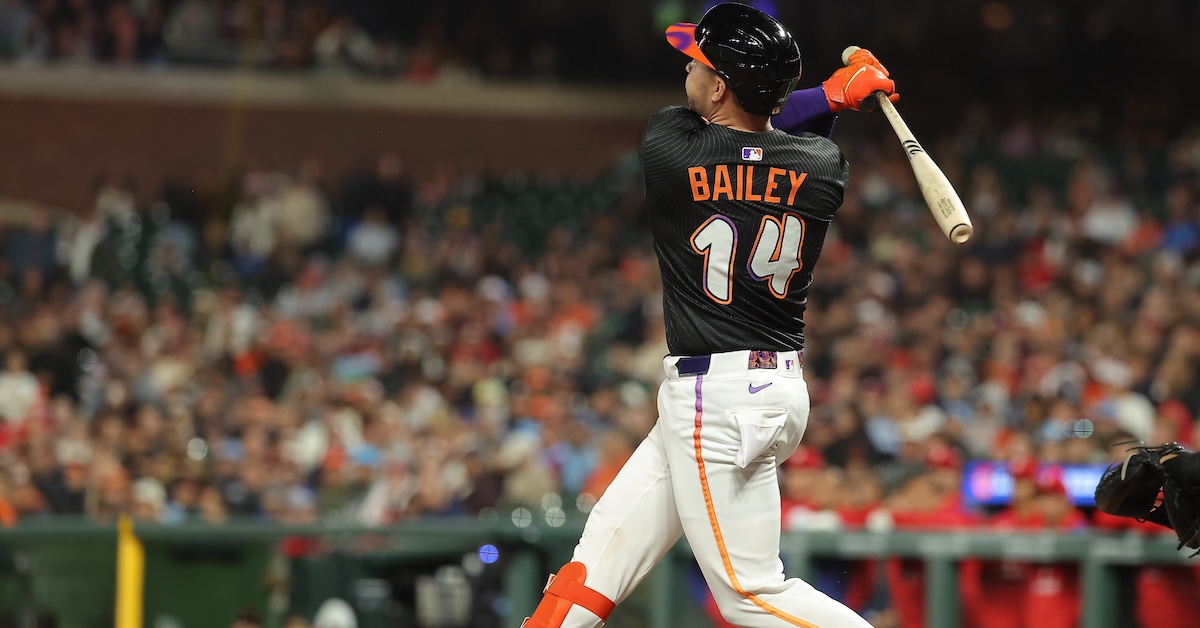
Welcome to another edition of Five Things I Liked (Or Didn’t Like) This Week. Today that title is a bit of a misnomer; I got back from vacation Monday night, so I saw very little baseball before Tuesday. That said, I didn’t need to see very much to have a great time. This week has been awesome. Home runs both mammoth and inside-the-park, great baserunning by slow guys, bad baserunning by slow guys, reflex plays and dekes; the list goes on and on. We might need the All-Star break just to catch our collective breath before a bustling trade deadline and sprint to the finish. For now, though, let’s just marvel at the week – after my customary nod to Zach Lowe of The Ringer, of course.
1. Unconventional Double Plays
Cody Bellinger has been great addition to the Yankees after they acquired him for peanuts over the winter. He is flashing the offensive prowess that has come and gone over the years, and with Trent Grisham manning center, he is playing the corner outfield more than he has in the past. His glove isn’t as good as it was at his peak, but putting a center fielder in left is still a plus for your team defense, as the Mets learned on Sunday. This Juan Soto line drive would have been a hit against almost anyone else:

Statcast gave it a 25% catch probability, and I think it was probably even harder than that. Catch probability measures how far Bellinger had to run and how much time he had to do it, but that ball was absolutely scalded and had so much topspin that it was hooking down hard in the brief time it was in the air. He caught it by the very end of the webbing; “baseball is a game of inches” is usually about the bat hitting the ball or a bang-bang play, but in this case, one inch separated a catch from extra bases:

Oh yeah, then this happened:

That throw is as good of a play as the catch! At full extension, stretched out awkwardly to secure the ball, Bellinger still managed to find first base on the run and unleash an absolute seed that hit Paul Goldschmidt right in the glove on the fly. Making that catch was hard enough. Making it without falling was even harder. Making it without falling and then throwing a frozen rope on target? Almost unthinkable.
Even after that catch, even with that throw, you might wonder why Francisco Lindor got doubled off. Partially, he couldn’t believe anyone could catch that line drive. Partially, too, he got deked. Goldschmidt no-sold the play, barely moving his glove until he absolutely had to. This isn’t the body language of a guy desperate to turn a double play:

That’s not the perfect angle, but you get the idea. The rhythm of this play, to Lindor, didn’t feel like the kind where he’d need to sprint and dive back to first. When someone makes a play that good, you turn around and go back, but what are they going to do, unleash an off-balance missile while the first baseman you’re staring at barely moves? Apparently, yes!
2. Irrational Exuberance
Vladimir Guerrero Jr. is not a good baserunner. That’s not an opinion. He’s been below average in each year of his major league career. He has 24 career steals and has been caught stealing 12 times. He’s slow, and he hits into a lot of double plays. But despite all that, Vlad likes to run. Give him the chance, and he’ll take off. Take Wednesday, for example. Guerrero took advantage of an errant pickoff throw to scamper to second:

You’ve seen that play a million times. Everyone was pretty relaxed about it; in the game audio, you can actually hear Jays first base coach Mark Budzinski calmly telling Vlad “go ahead, go ahead.” But the play wasn’t over:

Yeah, don’t do that. I’ve already mentioned that Guerrero isn’t fleet of foot, but it also took him forever to get moving; acceleration isn’t a strength either. Watch his feet – his first step was actually backwards, out into right field. Adrian Houser was on the wrong side of the mound, but Vlad just didn’t have enough straight line speed to make it matter. To make matters even worse, that was the third out of the inning, at third base, with Addison Barger — one of the teams’ hottest hitters — at the plate. Against the White Sox! Don’t do this.
Don’t do this either:

Now, to be fair, this is a tougher play than before. The underlying cause, though, is similar: a belief that baserunning is easier than it actually is. Elite runners might be safe there. That said, elite runners are a lot faster, and better at sliding, and they’d probably take two steps to their left to better block the throwing lane. That should be an extremely difficult throw for a right-handed first baseman, instead of the easy pitch-and-catch that it was. And once you’re dead to rights, well, hitting the brakes and retreating is a better option than starting your slide so early. You probably won’t survive the rundown, but you might stay in it long enough to give the runner on third time to score before you’re tagged for the final out of the inning.
To Guerrero’s credit, he did try a nifty maneuver at second that nearly rescued the whole thing:

Again, though, leave the high-difficulty baserunning stunts for the high-talent baserunners. Both of these decisions would be excellent if, say, Trea Turner had made them. Knowing what you can accomplish is a key part of accruing value on the bases. Watching what happens when that crucial step doesn’t occur sure is fun for a neutral observer, though.
3. One-up-manship
Kyle Schwarber had himself a game on Tuesday night. He went 2-for-4 with a double and a home run, and that homer was outrageous. Not only did he hit it into McCovey Cove, but he did so more or less flat-footed:

He even showed off another facet of his game an inning earlier, swiping second base off a distracted Robbie Ray:

That brought Schwarber to nine steals on the year, with only one caught stealing. He’s one of the slowest runners in baseball, but he understands the proper application of that speed, generally stealing bases off pitchers who forget about him. He’s not a particularly good baserunner overall, but he’s been picking smart spots to go this year.
One batter later, though, Schwarber tried to double up on his baserunning feat by swiping third. Enter Patrick Bailey:

Schwarber had a great read on Ray; he got an excellent jump in a great spot to steal, with the batter screening the catcher at the plate. Bailey just did everything he had to do that much better:

Watch his footwork there. He cleared batter Alec Bohm and got his lead foot planted at the back of the batter’s box while he was catching the ball. The catch and transfer were both perfect, letting him throw in rhythm. The throw? A laser beam to Matt Chapman’s glove for a tag that got Schwarber by an inch or two. I don’t think Schwarber could have done anything better; he just got beat by perhaps the best defensive catcher in the game.
Bailey is having a miserable season at the plate, but he even outdid Schwarber there, too. The Schwarbomb in the seventh put the Phillies up 3-1, and the score stayed there until Bailey batted with one out in the ninth. Then, well:
It’s hard to imagine a more exciting walk-off than that, and it made for the perfect kicker to this game. Sure, Schwarber had a stolen base and two-run homer, but Bailey had a caught stealing and a walk-off, three-run, inside-the-park homer. Real “anything you can do I can do better” vibes.
4. Two-Way Excellence
Oh, you like inside-the-park home runs? Northern California has your back:

That’s Lawrence Butler leading off the home half of the first for the A’s with an only-in-Sacramento play. It involved the ball kicking off of a chain link fence section of the wall and eluding the entire Braves outfield. That let Butler score even with one of the most nonchalant starts to an inside-the-parker you’ll ever see:
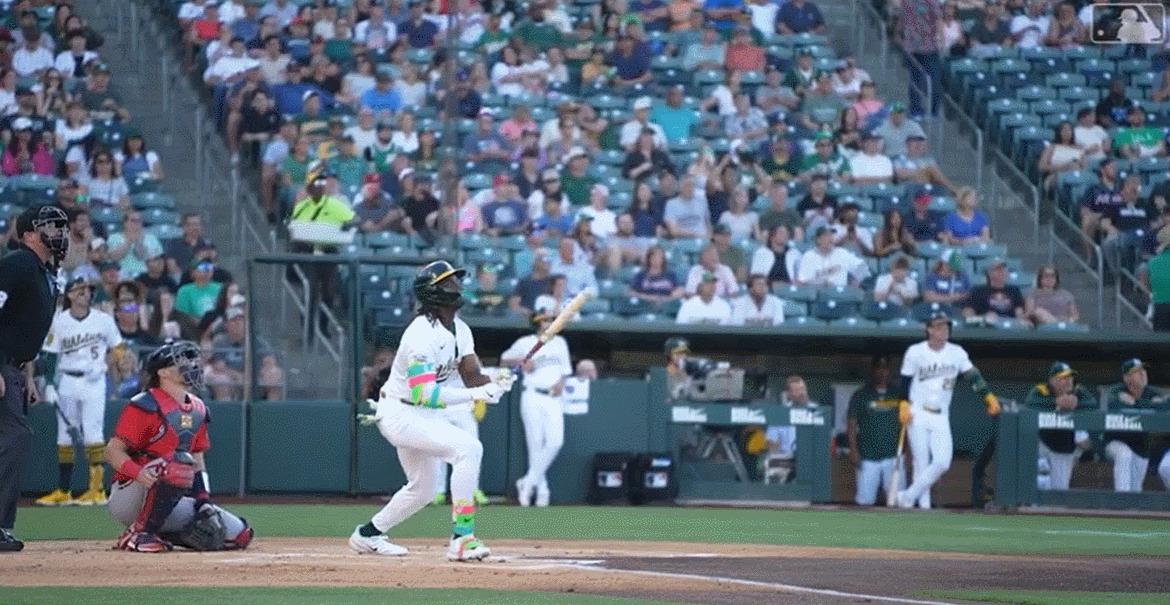
That’s the stride of someone who thought he hit the ball out of the park, but the crazy carom and Butler’s speed made it all work in the end. That’s been a hallmark of his game this year, in fact. He’s not the best defender in the world, but he’s got enough range and instincts to make up for a scattershot arm. He has plenty of swing-and-miss in his game, but he has enough plate discipline to keep his strikeouts from capsizing his offensive contributions. He’s a savvy baserunner capable of hitting top speed faster than you’d think. And he has enough power to make up for any small flaws elsewhere:

Inside the park? Outside the park? Butler has the speed/power combination to accomplish both. He looks like a nice building block of the next good A’s team – not this year’s team, of course, but maybe next year’s. After 1,000 major league plate appearances, it seems pretty clear that he’s a solid all-around player but not quite a star. That’s just fine for both the contract and the prospect pedigree, though – and as a huge bonus, he’s tremendously fun to watch. More home runs like these, please.
5. Raw Power
More home runs like these, too. Jac Caglianone was playing college baseball last year. The sixth pick in the 2024 draft, he looked more like a developmental stash than a plug-and-play star. He played both ways in college, though he was clearly a lot better offensively, and the Royals drafted him with that in mind. But he was raw, with iffy command of the strike zone and a swing-first mentality that led to ugly swings over sliders.
A whirlwind tour of the minors – 158 wRC+ in Double-A, 164 in Triple-A – convinced Kansas City to call him up at the beginning of June. Through just over a month of play, the results have been disappointing; Caglianone is hitting .151/.205/.286, for a 31 wRC+. But the results are lying. He’s been much better than I thought he’d be, to be quite honest. He’s running a 22% strikeout rate, far lower than I would have expected given that he’s chasing 41% of the pitches he sees outside the strike zone, one of the worst marks in the big leagues. The stats might be rough, but the process isn’t; by xwOBA, he’s been about an average hitter, rather than 70% below average, thanks to his prodigious exit velocities.
In other words, over the long run. Caglianone is going to hit for a lot of power. He’s already hitting the ball very hard, in fact, he just hasn’t quite harnessed that into doubles and dingers. But oh my god, have you seen what it looks like when he gets hot? Tuesday night, he did this:

If you want to know how scalded that ball was, watch the outfielders. Those are courtesy jogs, not “maybe I can get this one” sprints. That was 114 mph off the bat, the kind of home run that only the Judges and Stantons of the world can consistently pull off. When you hit the ball that low (19 degrees), it’s hard to leave the stadium. Caglianone is part of that group of elite power hitters already.
One hard-hit ball often begets another. His results so far have been poor, but he’s clearly close to unlocking something. If you leave a pitch over the middle of the plate against Caglianone, it’s going to travel a long way. Look at this nonsense from the next day:

That’s not a reasonable place to hit a home run. It went 466 feet, some real Bo Jackson stuff. I had the volume cranked up on this game, and the crack of the bat was so thunderous that the entire crowd went “ooooh” in unison. He might not have hit that ball quite as hard as the previous one, but he got it at the perfect angle and still tattooed it. His power binges are park-proof; Kaufmann Stadium is the stingiest stadium in baseball for left-handed power hitters, but if you hit the ball as hard as Caglianone does, it doesn’t matter where the fence is.
I didn’t think Caglianone was going to hit the majors this quickly. I’m still kind of surprised at how well he’s adapted to big league pitching; he’s getting attacked relentlessly on the inside part of the plate and chasing 40% of the time, and yet still running reasonable strikeout rates. But I’m not at all surprised at how fun he is to watch – and I can’t wait for more rainmaking home runs, and more mob movie celebrations in the dugout:

Michael Busch Swings Smarter, Not Harder
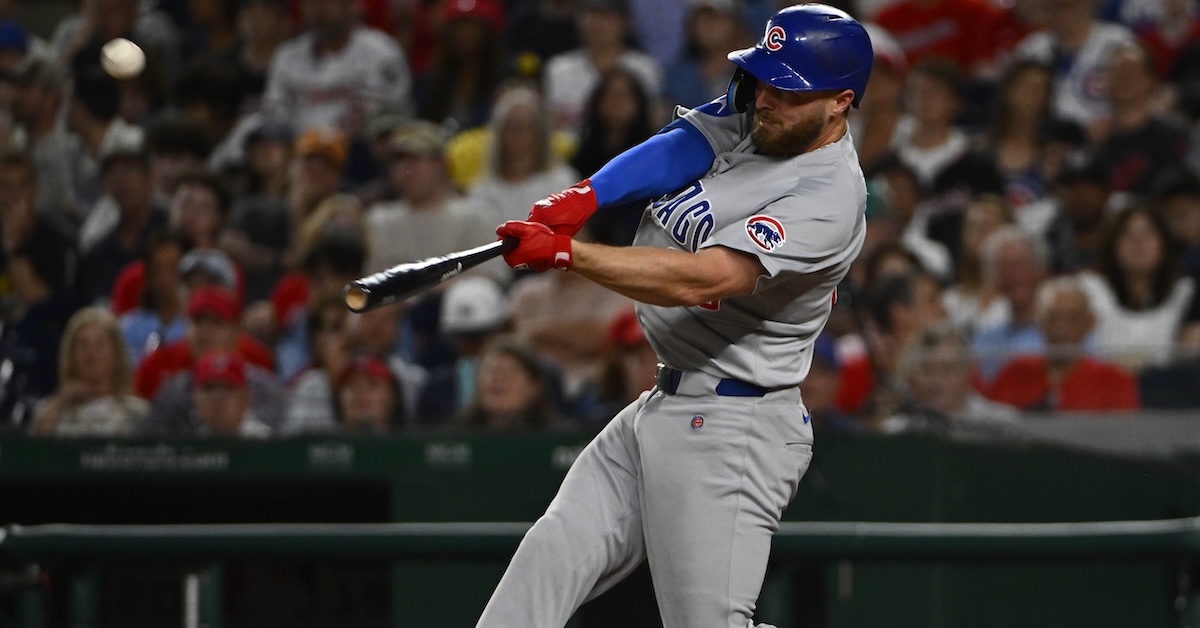
Michael Busch had a pretty nice 2024. In his first taste of everyday playing time in the majors, he hit .248/.335/.440 and socked 21 homers on the way to a 118 wRC+. After years spent in the minors in the Dodgers system, he looked to finally be delivering on his high-strikeout, high-BABIP, high-doubles promise. The Cubs penciled him in as their everyday first baseman. That’s not an imposing batting line, but it’s better than average, so the team spent its winter trading for Kyle Tucker, not trying to upgrade from an already-acceptable situation at first base.
You’ll notice that I said high doubles instead of high power. That’s because Busch had desultory bat speed numbers; he was in the 24th percentile with a 70.3-mph average swing speed. It wasn’t an issue of him having a hard swing and a soft swing that he deployed at different times, either. His fast-swing rate, or the percentage of his swings measured at 75 mph or higher, was a mere 11.3%; league average is around 23%. Busch was adept at getting his barrel to the ball and posting good exit velocity numbers, but that’s generally a recipe for doubles instead of homers. He hit 28 doubles, two triples, and 21 home runs last season, about what was expected from his profile. He got the ball in the air a lot and still hit for a high BABIP – sounds pretty good to me.
What do you think Busch could do to improve his performance in 2025? My immediate answer: Swing faster and hit more homers. Hey, check it out! Busch has already hit 18 homers this year in just over half a season. He’s on pace to shatter his performance last season in pretty much every statistic. He’s hitting .297/.382/.562 with a 165 wRC+. There’s just one problem with my swing-hard-and-prosper theory: He’s not swinging harder. Read the rest of this entry »
Five Things I Liked (Or Didn’t Like) This Week, June 27
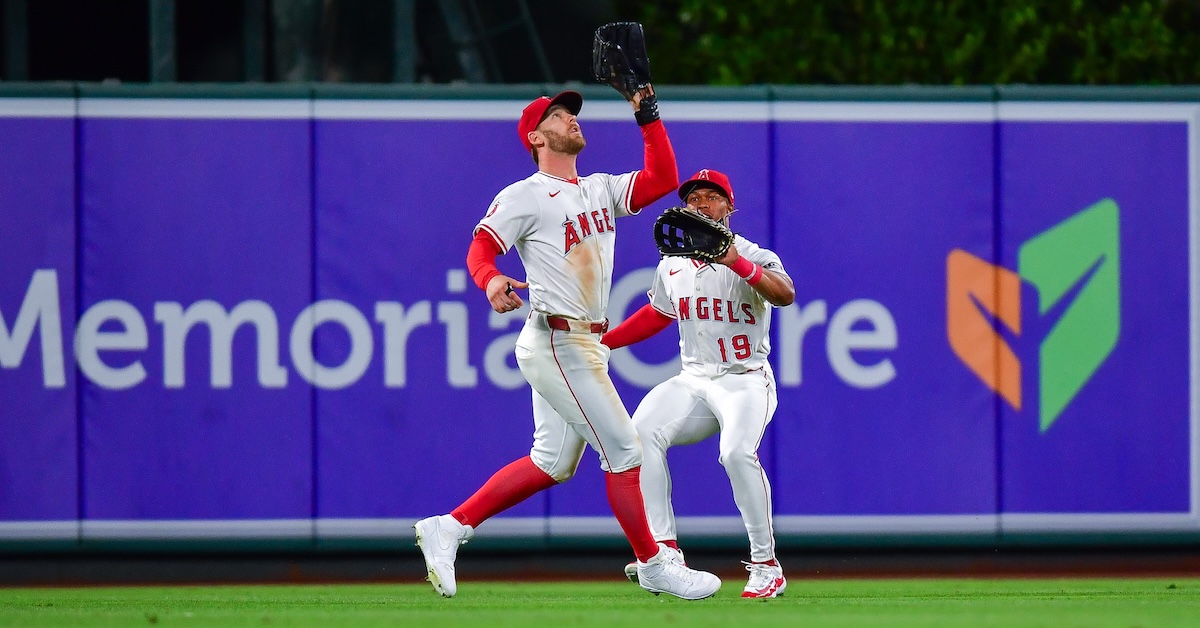
Welcome to another edition of Five Things I Liked (Or Didn’t Like) This Week. I got a chance to see many of my favorite baseball happenings this week: catchers making tough plays, exciting pitching matchups, and stars of the game at their absolute best. We also have plenty of goofy but delightful coincidences, just as Five Things patron saint Zach Lowe intended. A quick programming note: I’ll be on vacation, a nice restorative pre-deadline trip, for the next week and change. Enjoy baseball in the meantime – it’s a wonderful time of year for it.
1. Athletic Catchers
It’s amazing how much baseball knowledge your brain absorbs without actively thinking about it. For example, when you see an outfielder throw the ball home to cut down a runner trying to score on a single, you’ll immediately anticipate that the batter who hit that single might try to advance to second base. You might not even realize you’re thinking this. It’s just the natural timing of the sport. Long throw, cutoff man missed — how in the world is the catcher going to attempt a tag and then find a way to get the ball down to second base? It just doesn’t happen.
Or, well, it’s not supposed to happen. But Carlos Narváez doesn’t care what heuristics are stored in your brain:

What a weird play. The Red Sox correctly played to prevent the runner from scoring, and that let Wilmer Flores round first and get a great look at the play at the plate to see if he should advance. Right around this point, Narváez seemed to have no shot at throwing out Flores:
Will Warren’s One Weird Trick
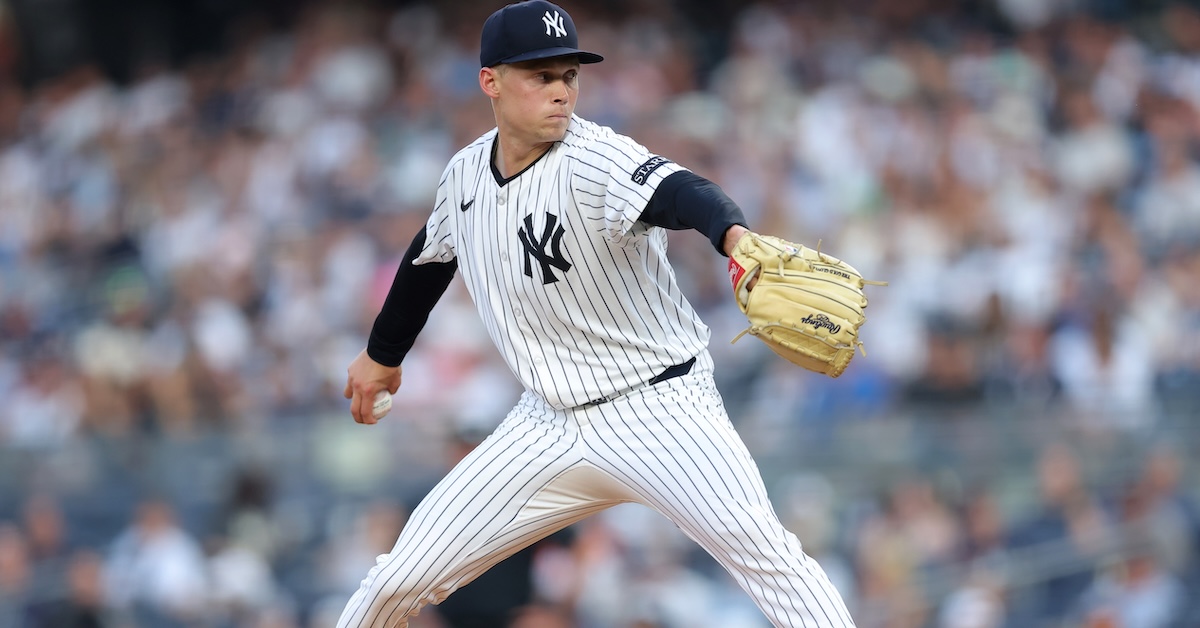
Will Warren’s best pitch is a sweeper. That’s the case for a lot of pitchers in baseball today, of course, but his rendition is almost the platonic ideal of the pitch: low-80s velocity, very little vertical movement in either direction, and a huge, comic-book-exaggerated horizontal hook. The ball briefly looks possessed on its flight home:

No, your eyes aren’t deceiving you: That’s a really sweep-y sweeper. No one in baseball gets more horizontal movement on his sweeper than Warren, in fact. From his slingy, low-three-quarters arm slot, he generates the sweep the pitch is so known for, working it across the plate to righties or darting it in to steal a front-door strike against lefties. It’s Warren’s signature pitch, the secondary offering he uses most frequently, and he has it on a string. He throws it more frequently when behind in the count than ahead, believe it or not, and floods the zone with unerring precision.
The natural pairing for that sweeping slider? Warren’s excellent sinker, which dives and tails arm side, falling four more inches and tailing two more inches than your average 93-mph sinker. That movement confuses opposing hitters to no end. He’s induced called strikes on around a third of the two-strike sinkers he’s thrown all year, the best mark in the majors. You can see why:

That, in a nutshell, is the promise of Will Warren. Major league pitchers are increasingly adopting a sinker/sweeper approach when they face same-handed opposition, and Warren is one of the best there is at sinking and sweeping. That was the promise that made him a Top 100 prospect – two elite pitches, the ability to mix in a four-seamer, changeup, and curveball to keep batters off of those two premium offerings, and enough command to sew it all together. It’s working. Though he’s suffered from poor sequencing luck (65.2% left-on-base rate, one of the lowest in the majors among starters), his 2.88 FIP, 3.37 SIERA, and 3.58 xERA all point to his effectiveness so far.
Read the rest of this entry »
Riley Greene’s Strikeouts Aren’t a Dealbreaker
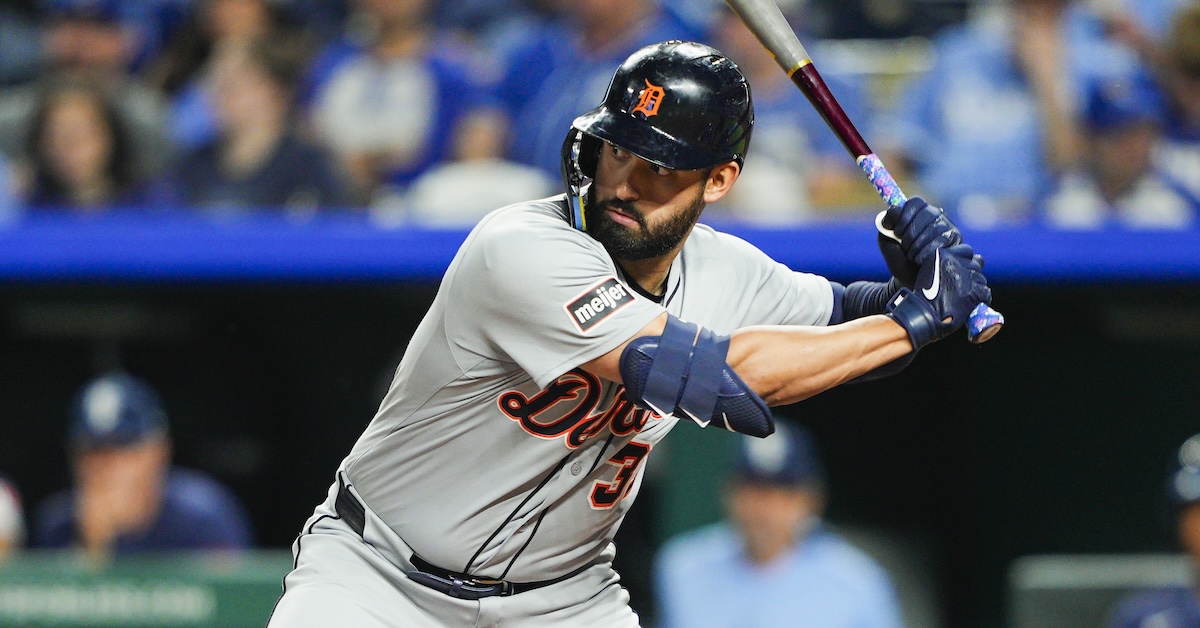
When Riley Greene debuted in 2022, he had a tiny bit of a strikeout problem. His overall line – .253/.321/.362 in cavernous Comerica Park – was roughly league average, but it would have been better than that if he had struck out less than 28.7% of the time. Over the subsequent two years, he reined that issue in some: 27.4% in 2023 and 26.7% in 2024. He also got better at the plate while doing so. And this year, he’s off to a scorching start, .291/.345/.530 with a career-best 145 wRC+. So he conquered the strikeout demons, right? Wrong. He’s striking out a ghastly 30.7% of the time. This requires further explanation.
One of the classic paradoxes driving the way baseball looks today is that strikeouts don’t appear to be as bad for hitters as one might think. There’s essentially no correlation between batter strikeout rate and overall batter production. You could crunch the numbers to verify that – or you could just consider Luis Arraez and Aaron Judge. But while we pretty much all know this by now – the Judges and Harpers and Ohtanis of the world crack a few eggs while they’re depositing omelets over the outfield fences – it doesn’t feel as true at the extreme high end of the spectrum. After all, Joey Gallo’s outlandish 38% strikeout rate obviously held him back. But Gallo is the easiest example, and discussing his strikeout woes doesn’t quite prove a whole lot. So let’s look at the 10 hitters striking out most this year:
| Player | K% | BB% | AVG | OBP | SLG | wRC+ |
|---|---|---|---|---|---|---|
| Logan O’Hoppe | 33.5% | 4.2% | .233 | .268 | .471 | 101 |
| Oneil Cruz | 33.1% | 14.0% | .211 | .328 | .414 | 104 |
| Luis Robert Jr. | 31.4% | 9.7% | .185 | .267 | .305 | 59 |
| Gabriel Arias | 31.1% | 6.4% | .230 | .293 | .360 | 85 |
| Riley Greene | 30.7% | 7.5% | .291 | .345 | .530 | 145 |
| Ryan McMahon | 30.7% | 13.3% | .222 | .327 | .410 | 94 |
| Trevor Story | 30.5% | 4.5% | .231 | .274 | .359 | 71 |
| Jorge Soler | 29.8% | 8.3% | .207 | .280 | .350 | 76 |
| Matt McLain | 28.9% | 10.3% | .209 | .301 | .351 | 79 |
| Kyle Stowers | 28.4% | 9.1% | .270 | .343 | .467 | 122 |
Aside from Greene, that’s not an impressive group. Stowers is the best of the bunch, but even including him, the aggregate statistics are quite poor. This isn’t some list of overmatched hitters doing absolutely nothing right, ether; there’s fearsome power here pretty much across the board. They’re just striking out so much that the overall package doesn’t work. So why does Greene look so different from the rest?
It starts, as MLB.com’s Jared Greenspan pointed out, with aggression. Greene spent his first years in the majors as a patient hitter, chasing less often than average and taking a few pitches in the zone as the price of his patience. My favorite proxy for hitter aggression is how often they swing at first pitches in the strike zone. The league as a whole swings at about 45% of such pitches. Greene was right around there in his first three years in the big leagues: 42.4%, 45.2%, 46.1%, respectively. Then he decided to stop letting those cookies go by. This year, he’s swinging at 56% of first-pitch strikes.
The reason for this is simple: These are good pitches to hit. From 2022 through 2024, Greene put up great numbers when he made contact with a first-pitch strike. He batted .425 and slugged .770 on them, with underlying contact metrics to match. He’s doing even more damage this year, .448 with a .966 slug. More importantly, though, he’s damaging these pitches more frequently because he’s swinging at them more often. These tend to be the best pitches to hit all plate appearance; why not take a big hack at them?
There’s a cost to doing this. Greene is also swinging more often at bad first pitches; his 0-0 chase rate is up to 18.5% from roughly 12% in his career before the season began. That sounds bad, but consider that he’s upped his in-zone swing rate by 10 percentage points. Because of this aggression, he is no longer taking as many hittable pitches for strikes. Take a look at how often he’s gotten ahead, fallen behind, and put the ball in play over time:
| Year | In Play | 0-1 | 1-0 |
|---|---|---|---|
| 2022 | 8.8% | 52.1% | 39.0% |
| 2023 | 8.0% | 49.9% | 42.2% |
| 2024 | 9.1% | 51.2% | 39.7% |
| 2025 | 10.2% | 49.1% | 40.7% |
As you can see, this has been a great trade-off. He’s putting the ball in play more frequently than ever and falling behind less often as a result. Aggression pays, particularly early in the count and particularly for hitters as powerful as Greene.
That smidgen of extra production against hittable pitches in early counts helps explain some of Greene’s boosted production on batted balls this year – his .525 wOBACON and .504 xwOBACON are both career highs (here’s why I like these BACON stats). Want to mash the ball? Aim at easier pitches.
That said, Greene’s aggressive approach to pitches in the zone has come with some swing-and-miss downside. Break the plate down into more than just “in or out” and you can see the trade-off more clearly:
| Year | Heart | Shadow-In | Shadow-Out | Chase | Waste |
|---|---|---|---|---|---|
| 2022 | 69.3% | 58.3% | 44.7% | 22.5% | 4.0% |
| 2023 | 75.2% | 60.7% | 39.7% | 21.8% | 5.9% |
| 2024 | 72.9% | 58.3% | 38.0% | 17.5% | 3.7% |
| 2025 | 78.0% | 64.3% | 46.6% | 25.7% | 5.9% |
Naturally, Greene is swinging more at everything in his attempt to drive more hittable pitches. That makes sense; he didn’t simply wave a magic wand and start swinging at the good ones more without adjusting his approach to all pitches. He’s not hacking blindly at everything off the plate, or even close to that, but it makes plenty of sense that he’s taking a few more ill-advised swings along with all the extra good ones.
Normally, you’d expect this to be a self-correcting loop. Greene gets more aggressive, so pitchers leave the strike zone more often, which tilts Greene back toward selectivity as he gets ahead in the count more often and can choose pitches to hunt. Early in the count, pitchers are treating him about the same as always – he’s powerful, and so they try to nibble around the corners of the zone, accepting extra balls in exchange for avoiding meatballs. But with two strikes, particularly if you exclude 3-2 counts, they’re not giving him so much as the time of day. He sees strikes on a mere 35.3% of 0-2, 1-2, and 2-2 counts, one of the lowest marks in baseball.
That feels like a wise adjustment by opposing pitchers. This guy is powerful and wants to swing, so why bail him out by giving him something to hit? So he faces a steady diet of breaking balls in the dirt, high fastballs, sinkers off the plate in, basically everything you can think of. There’s an adjustment to be made here, starting aggressive and dialing it back with two strikes instead of maintaining that aggression all the way through. In 2024, he chased 30.3% of the time in those counts. This year, he’s up to 39.1%. That’s from “much less than average” to “more than average” if you’re keeping score at home.
The end result of this newfound aggression and pitchers’ avoidance of the zone is that Greene is striking out on 22.8% of the two-strike pitches he sees, the highest mark of his career. He’s also getting to two-strike counts more frequently thanks to his early-count swings. He’s fouling more pitches off than ever before, as well. That comes with the swing-hard-early territory; Greene will happily take some foul balls in exchange for all the damage he’s doing when he keeps the ball fair.
As far as I can tell, Greene is like no one else in the high-strikeout cohort. He’s not up there because he’s a helpless hacker who can’t make contact. He has a good sense of the strike zone, one he’s displayed in multiple seasons. His swing is geared for power, so he’ll always swing over his fair share of balls, but plenty of hitters with power swings still have good two-strike approaches. Greene just hasn’t put together his new early-count plan – attack pitches in the zone and accept a few extra chases to do it – with a two-strike approach. He’s chasing too often, and as best as I can tell, it’s because he’s swinging more frequently than ever before early in the count. It’s tough to switch mental gears, particularly while you’re learning a new approach, and I think Greene has fallen into that trap so far.
All this is to say Greene is hardly doomed to strike out 30% of the time for the rest of the year. In fact, I think his early-count aggression will end up lowering his strikeout rate, not raising it. He’s giving pitchers fewer easy options by hunting drivable pitches early. And in previous seasons, he’s already demonstrated the ability to tighten up and manage the zone late in the count. He’s still just 24 years old and only in his sixth year of professional baseball (excluding the canceled 2020 minor league season). Unlike most of the players who strike out as often as he does, he seems to have no fatal flaw that will keep him in that group. It’s just a matter of making all the parts of his ever-improving game work together, and I definitely wouldn’t bet against him fixing it sooner or later.
It’s a credit to his incredible talent that his horrid strikeout rate hasn’t really mattered so far. I love his new approach this year overall. When you have this level of power, letting early-count strikes go by is a cardinal sin. I think he’ll figure out how to modulate that as necessary – when he gets behind and pitchers start fishing for strikeouts, basically. But if you’re looking for a testament to Greene’s talent, I can’t think of any better one than his performance this year. He’s striking out a truly unconscionable amount while he tries to change the way he works at the plate, and yet it doesn’t matter. He’s just that powerful, and even though he’s aggressive, he’s not flailing pointlessly at pitches out of the zone and blunting his results on contact. The strikeouts will almost certainly come down. The new, early-count damage? That’s here to stay.
Five Things I Liked (Or Didn’t Like) This Week, June 20

Welcome to another edition of Five Things I Liked (Or Didn’t Like) This Week. I won’t try to slow-play it; there was nothing I didn’t like this week. Baseball is freaking great right now. There are huge blockbuster trades that ignite passionate fanbases, for better or worse. The playoff chase is starting to heat up as we approach the All Star break. Crowds are picking up now that school is out. The weather is beautiful in seemingly every stadium. We’ve entered San Francisco Summer, which means it’s a lovely 57 and foggy most days here, ideal baseball weather for me (and you, too, if you live here long enough to acclimate). So I have no bones to pick this week, nothing that irked or piqued me. It’s just pure appreciation for this beautiful game – and, as always, for Zach Lowe of The Ringer, whose column idea I adapted from basketball to baseball.
1. The Streaking… Rockies?!
The hottest team in baseball right now? That’d be the Red Sox or Dodgers, probably – maybe the Rays or Astros depending on what time horizon you’re looking at. But if you adjust for difficulty level, it has to be the Rockies, who were one James Wood superhuman effort (two two-run homers in a 4-3 victory) away from a four-game sweep of the Nationals. Add that to their Sunday victory over the Braves, and they’re 4-1 in their last five. That could have been a five-game winning streak!
Sure, baseball is a game of randomness. Every team gets hot for little micro-patches of the season. But, well, this feels like the biggest test of the “anyone can do anything for 10 games” theory in quite some time. These Rockies are terrible. Their everyday lineup features six players with a combined -1.4 WAR this year. Those the starters – the bench is worse than that. Their rotation has an aggregate 6.23 ERA. They’ve been outscored by 196 runs this year; the next-closest team is the Athletics at -128. Read the rest of this entry »
How Quickly Should You Change Your Mind About Elite Pitching Prospects?
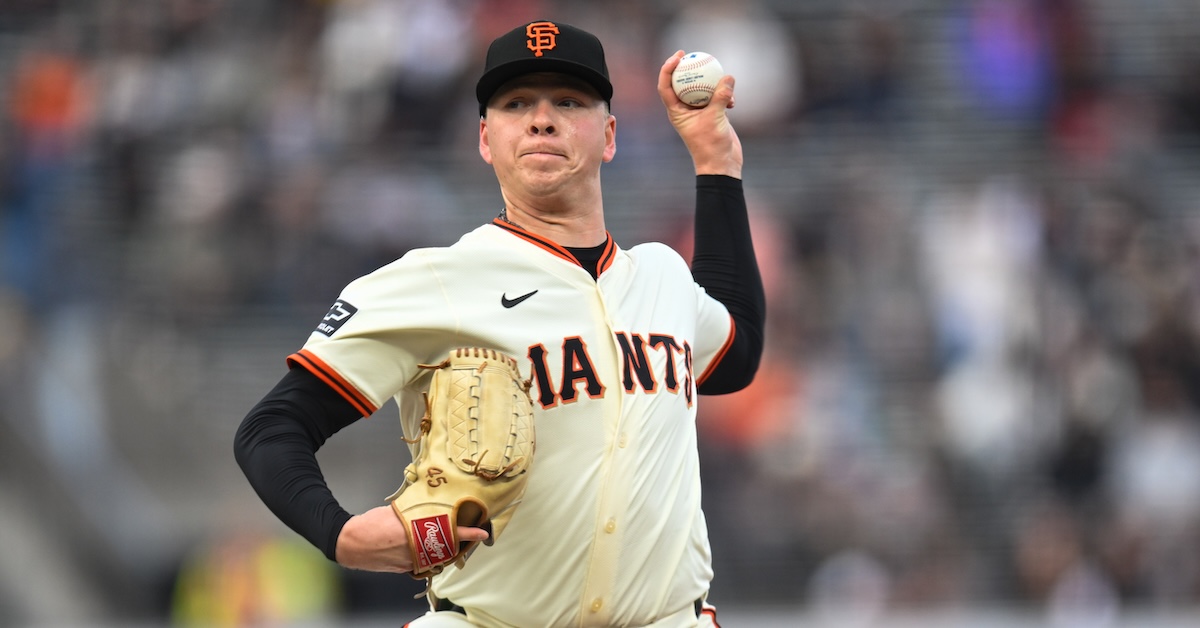
As you might have heard, the Red Sox traded Rafael Devers to the Giants earlier this week. In my breakdown of the deal, I ranked the players headed to Boston in the order of my interest in them: James Tibbs III, Kyle Harrison, Jose Bello, and lastly Jordan Hicks, though that’s contract-related, as I think he’s probably the best current player of the four. The next day, someone in my chat asked me why I preferred Tibbs to Harrison – was I particularly high on Tibbs, or particularly low on Harrison? After all, Harrison was a consensus top 50 prospect only a year ago, while Tibbs took his first Double-A at-bats this week.
My initial answer was that I saw Harrison several times last year, and he didn’t really do it for me. Combine that with his uninspiring results and the fact that other prospects had squeezed him out of the Giants rotation, and I preferred Tibbs. Since neither guy is clearly ready to dominate the major leagues right now, give me the higher-variance unknown quantity.
When I stopped to think about it later, though, I decided that my answer wasn’t good enough. Right now, I’m knee-deep in spreadsheets, linear regressions, non-linear regressions, projections, scouting reports, basically every type of baseball data out there as I do some initial work on our annual Trade Value Series, which will run next month. I have tons of prospect data stored up. I even looked into how prospect grades translate into major league players earlier this year. Rather than try to re-evaluate Harrison based more or less on vibes and ERA, I decided to apply a bit of analytical rigor now that I wasn’t writing for a deadline. Read the rest of this entry »
Let’s Analyze Shohei Ohtani’s Return to the Mound in Excruciating Detail
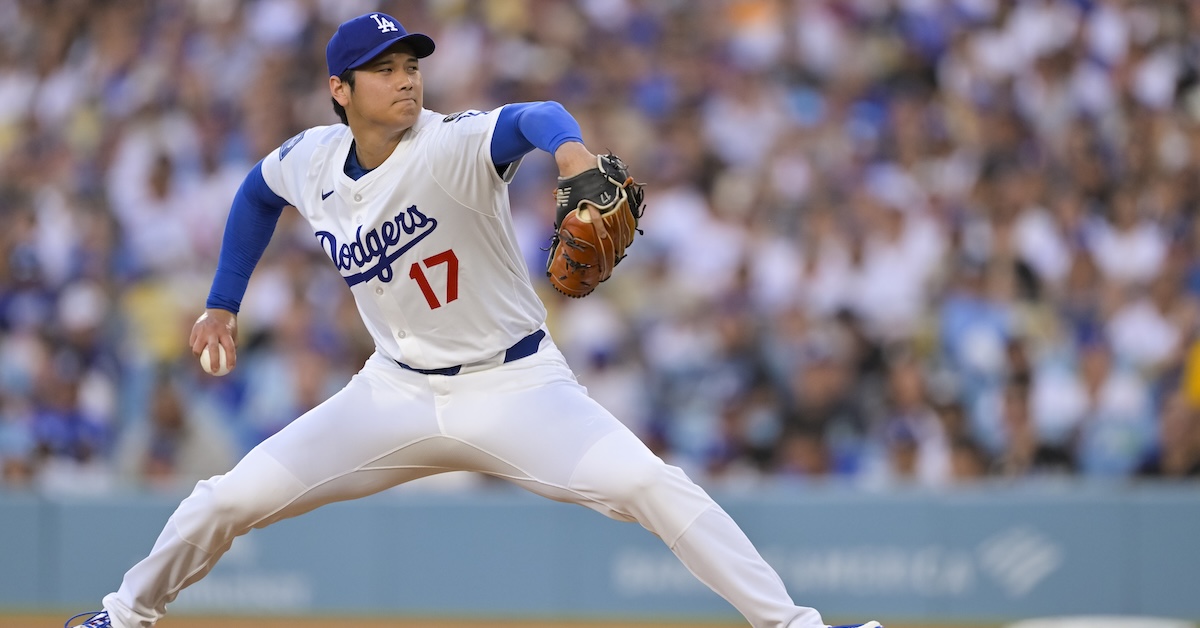
On Monday night in Los Angeles, Shohei Ohtani made his first major league start for the Dodgers. For any other starter signed before the 2024 season, that would be a disastrous sentence to type. Ohtani, of course, became the charter member of the 50/50 club, won the National League MVP, and then helped his team win the World Series. But he came to the Dodgers to hit and pitch, not just to play DH, and last night marked a key step in that process, his first game action as he rehabs from a 2023 elbow surgery.
I watched every pitch of Ohtani’s one-inning outing to compile a report. Obviously, these are the observations of a data analyst, not a scout. I’ve supplemented them with the Statcast and pitch model data generated overnight. I’m not the type to ignore the numbers, but realistically speaking, 28 pitches isn’t enough for a real sample, so the data is more supporting than primary. I’ll start with my first impressions, walk through each of the four pitch types Ohtani threw, and then share some general conclusions. Read the rest of this entry »

